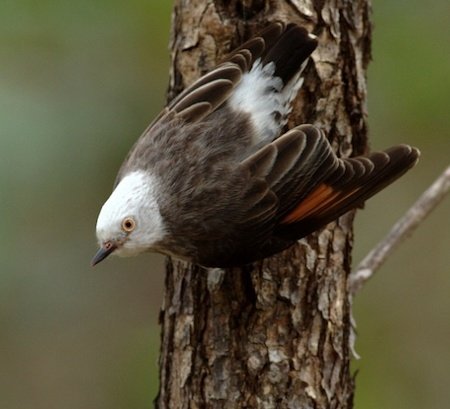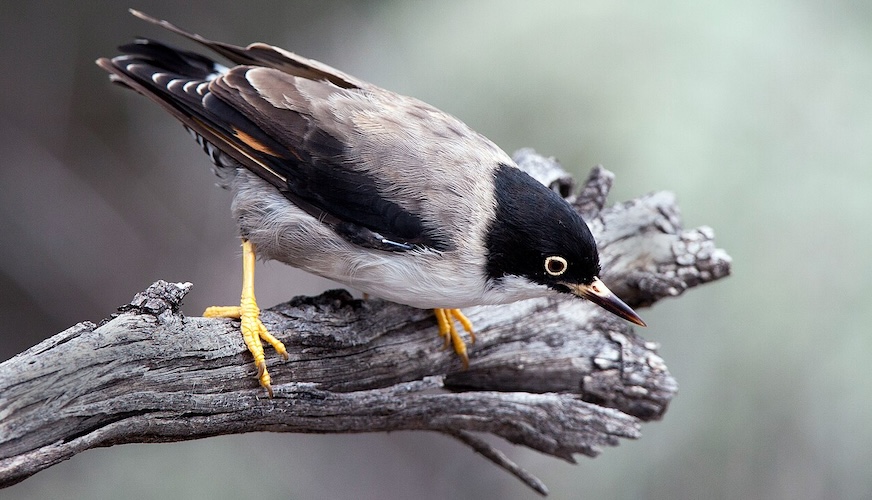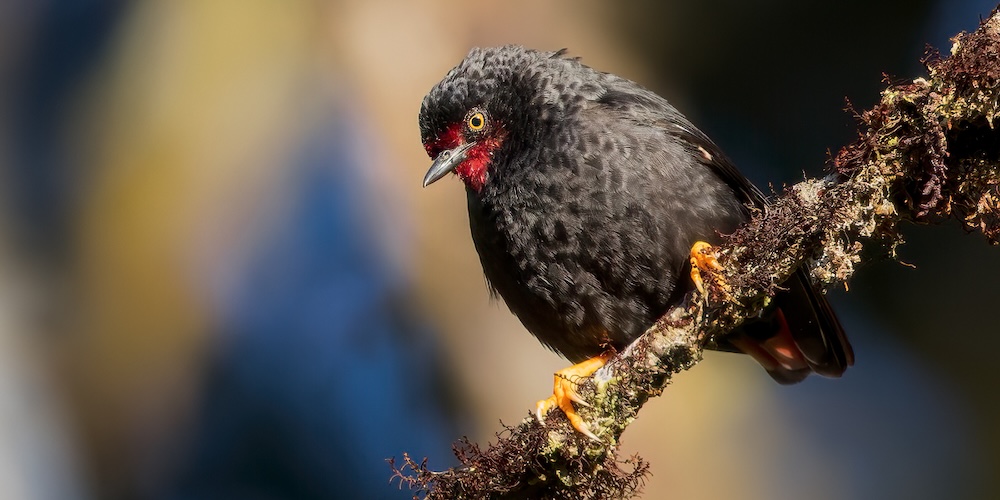Neosittidae – Sitellas

Neosittidae; the sittellas, are a family of small passerines found only in Australasia. They resemble nuthatches, but whilst they were considered to be in that family for many years, they are now afforded their own family. They do not migrate other than for local movements. They are small woodland birds with thin pointed down-curved bills, which they use to extricate insects from bark. Nests are open cups in forked branches.
They were formerly classified in two separate genera with the Black Sittella in Daphoenositta and the Varied Sittella and Papuan Sittella in Neositta. The two genera are now usually merged with Daphoenositta having priority.
The calls of sittellas are generally simple. Apparently, the family has no need for long distance territorial calls, and the majority of calls are simple contact calls utilised to retain flock cohesion. The most commonly heard call is the chip contact call, although there also exists a rallying call (to call together the group), as well as begging calls issued by incubating females.
The sittellas are social and generally restless birds of scrub, forests and woodlands. In Australia they generally avoid only the dense rainforest, whereas in New Guinea this is the only habitat they inhabit, avoiding only lowland forest. They generally live at low densities, between 0.1 to 0.6 birds per hectare, and are sedentary. They are highly social, usually being found in groups of five or more individuals and only more rarely in pairs. Studies of Varied Sittellas in New South Wales suggest that they live in clans of eight to twelve individuals and defend mutual territories against other groups. Within the groups, mutual preening is common, and in the evening the groups roost communally as well. Birds traveling to the evening roosts do so at slightly different times, timing their arrival at 30–60 second intervals, presumably so as not to attract the attention of potential predators. Roost sites are usually high in trees on slightly inclined dead branches. All the birds in the group roost next to each other, touching, and facing the same direction. Amongst Australian birds Varied Sittellas are usually the first to arrive at roost sites in the evening and the last to leave in the morning, although they are not necessarily the first to sleep or last to wake. At the roost site the position occupied along the branch is generally not random; instead, males tend to adopt positions at the edges of the group whilst young birds tend to be found in the centre.
The principal component of the diet of sittellas are insects and arthropods. In one study in new South Wales adult beetles were the most common component of the Varied Sittella’s diet; particularly favoured were weevils, ladybirds, leaf beetles (Chrysomelidae) and click beetles (Elateridae). A further quarter of the diet was composed of spiders and insects. Also taken were beetle and moth larvae, grasshoppers, termites, wasps and bees. The proportion of any one item in the diet apparently varies geographically and seasonally. The diet of the Black Sittella has, like other aspects of its biology, been little studied, although the stomach contents of one that were examined contained caterpillars and spiders.

Varried Sittella Daphoenositta chrysoptera – ©Peter Jacobs from Australia, CC BY-SA 2.0 via Wikimedia Commons
Sittellas forage on horizontal branches and the trunks of trees. Their foraging techniques has been described as hopping rapidly along the length of a horizontal branch, pausing briefly to peer for prey, occasionally hanging underneath the branch but usually on top of it. Most of the time is spent on branches rather than on the trunks. Birds on the trunks may travel upwards or downwards. Within the forest, sittellas usually forage in the canopy. There are sexual differences in foraging, with males and females choosing to forage in slightly different microhabitats within the tree. Prey items are usually gleaned directly from the bark, although in a few instances sittellas will sally from the branch in order to snatch aerial prey. Having obtained prey, sittellas will use their feet to hold it while they eat it, in a similar manner to parrots, and will also use their feet in order to hold back strips of bark in order to pry underneath it. There have even been isolated reports of tool use in some populations of sittellas. Sticks were used to pry boring beetle larvae out of cavities, in a similar fashion to that of tool using woodpecker finches of the Galapagos.
Very little is known about the breeding of either of the two species of sittella in New Guinea, although Black Sittellas in breeding condition have been observed August and May, suggesting that they may either be biannual breeders or year-round breeders. The Varied Sittella populations in Australia are cooperative breeders (and the group composition of Black Sittellas suggest they are too), and possibly have to be in order to be successful. There is some evidence that not only do groups cooperate in raising the young, not an uncommon strategy in birds, but have a plural breeding system, where more than one pair inside the group nest, and the group help raise both broods. There have even been instances of two females sharing a nest.

Black Sittella Daphoenositta miranda – ©Dubi Shapiro
95% of the nests found in a study in New South Wales were in stringybarks, particularly the species Eucalyptus macrorhycha. The nests were almost always located high in the tree. Nest construction took around 7 days, but lining and decorating the nest added a few days to this. Nest building duties were shared amongst the group, and the speed of construction depended on how many birds were involved. Nests are usually placed in the prong of two branches, and is a deep cup decorated in the bark of the tree it is built in, thereby camouflaging it. Around two to three eggs are laid and incubated by the breeding female (or females if two are sharing the nest) for nineteen to twenty days. Whilst incubating the breeding female is fed by the breeding male and helpers. After hatching the female broods the young for a few days, and for up to two weeks at night. The chicks are fed for nineteen to twenty days in the nest. After fledging the chicks have a protracted period of parental care lasting up to eighty days, although sixty days is more usual.
-
Number of bird species: 3
(As at December 2025)
According to the recently (2025) amalgamated AviList, there are just three species, in one genus in the Neosittidae family. They are:
Black Sittella Daphoenositta miranda
Papuan Sittella Daphoenositta papuensis
Varied Sittella Daphoenositta chrysoptera
-
Neosittidae
Family AccountThese short-tailed, light-limbed songbirds commute up and down branches and treetrunks in a series of short hops in a manner that recalls nuthatches... -
Neosittidae
Family AccountThe sittellas are a family Neosittidae of small passerine birds found only in Australasia. They resemble nuthatches...
Given that this is a very small family with just three species in a single genus, Fatbirder provides active links below to all species.
-
Black Sittella Daphoenositta miranda
Species AccountA small, rare nuthatchlike bird of upper montane forest canopy. -
Black Sittella Daphoenositta miranda
Species AccountThe black sittella (Daphoenositta miranda) is a species of bird in the Neosittidae family. It is found in Indonesia and Papua New Guinea. -
Black Sittella Daphoenositta miranda
Species AccountSound archive and distribution map. -
Papuan Sittella Daphoenositta papuensis
Species AccountTiny, short-tailed bird with a thin, slightly upturned bill. All plumages show yellow eyering and heavy dark streaks on the back and belly. -
Papuan Sittella Daphoenositta papuensis
Species AccountDaphoenositta papuensis is listed as Least Concern. -
Papuan Sittella Daphoenositta papuensis
Species AccountSound archive and distribution map. -
Varied Sittella Daphoenositta chrysoptera
Species AccountThe varied sittella (Daphoenositta chrysoptera) is a small, around 10–11 cm long, songbird native to Australia and New Guinea. It is also known as the Australian nuthatch, orange-winged sittella and the barkpecker. -
Varied Sittella Daphoenositta chrysoptera
Species AccountThe Varied Sitella is a small, short-tailed, dumpy bird which is usually heard before it is seen in the upper branches. There are five sub-species, differing in the patterns on the head and neck, the amount of streaking and in the wing patterns. -
Varied Sittella Daphoenositta chrysoptera
Species AccountSound archive and distribution map.
